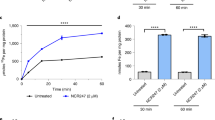Summary
Nitrate added at critical concentrations to plant growth medium inhibits the infection of legume roots by Rhizobium. The direct interaction, of nitrate and trifoliin A, a Rhizobium-recognition lection from white clover (Trifolium repens L.), was examined as a possible basis for this regulation. Selective molecular ultrafiltration studies to detect ligand-protein interactions showed that radioactive13NO3 − did not bind directly to trifoliin A when incubated at two molar ratios. Immunoprecipitation of trifoliin A by its homologous antibody was unaffected by 15 mM NO3 −. In addition, there was no apparent reduction in attachment ofR. trifolii 0403 to root hairs of clover seedings during 1 h of incubation in the presence of 15 mM NO3 −. These results show that nitrate inhibition of these early steps of the infection process is not due to a direct interaction of nitrate with trifoliin A or its glycosylated receptors.
Similar content being viewed by others
References
Dazzo F B and Brill W J 1978 Regulation by fixed nitrogen of host-symbiont recognition in the Rhizobium-clover symbiosis. Plant Physiol. 62, 18–21.
Dazzo F B, Hrabak E M, Urbano M R, Sherwood J E and Truchet G 1981 Regulation of recognition in the Rhizobium-clover symbiosis.In Current Perspectives in Nitrogen Fixation. Eds. A H Gibson and W E Newton, Australian Academy of Science, Canberra, pp 292–295.
Dazzo F B, Yanke W E, and Brill W J 1978 Trifoliin: aRhizobium recognition protein from white clover. Biochim. Biophys. Acta 539, 276–286.
Fåhraeus G 1957 The infection of clover root hairs by nodule bacteria studied by a simple glass slide technique. J. Gen. Microbiol. 16, 374–381.
Fred E B, Baldwin I L, and McCoy E 1932 Root Nodule Bacteria and Leguminous Plants. University of Wisconsin Press, Madison, 343 p.
Lowry O H, Rosebrough N J, Farr A L, and Randall R J 1951 Protein measurement with the Folin phenol reagent. J. Biol. Chem. 193, 265–273.
Munns D N 1968 Nodulation ofMedicago sativa in solution culture. III. Effects of nitrate on root hairs and infection. Plant and Soil 29, 33–49.
Paulus H 1969 A rapid and sensitive method for measuring, the binding of radioactive ligands to proteins. Anal. Biochem. 32, 91–100.
Payne W J and Riley P S 1969 Suppression by nitrate of enzymatic reduction of nitric oxide. Proc. Soc. Exp. Biol. Med. 132, 258–260.
Thornton H G 1936 The action of sodium nitrate upon the infection of lucerne root hairs by nodule bacteria. Roy. Soc. London Ser. B 119, 474–492.
Tiedje J M, Firestone R B, Betlach M R, Smith M S, and Caskey W H 1979 Method s for the production and use of nitrogen-13 in studies of denitrification. Soil Sci. Soc. Am. J. 43, 709–715.
Truchet G L and Dazzo F B 1982 Morphogenesis of lucerne root nodules incited byRhizobium meliloti in the presence of combined nitrogen. Planta Berlin 154, 352–360.
Author information
Authors and Affiliations
Rights and permissions
About this article
Cite this article
Dazzo, F.B., Hrabak, E.M. Lack of a direct nitrate-trifoliin A interaction in the Rhizobium-clover symbiosis. Plant Soil 69, 259–264 (1982). https://doi.org/10.1007/BF02374520
Received:
Issue Date:
DOI: https://doi.org/10.1007/BF02374520




